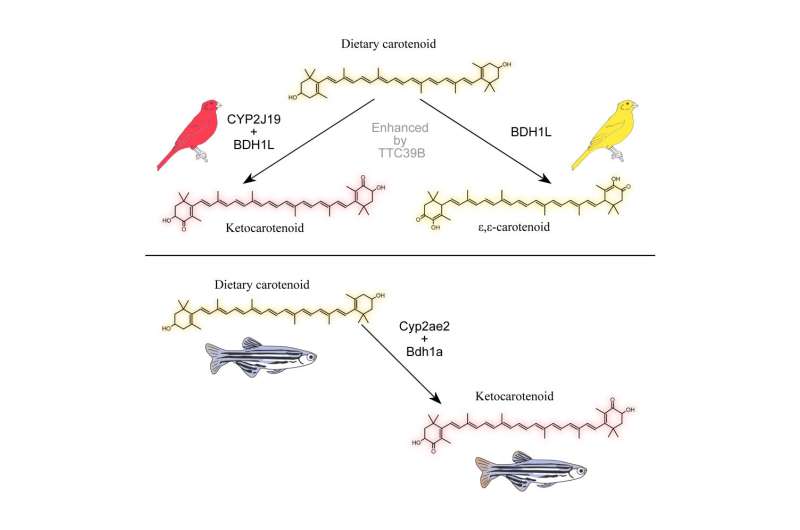Graphical abstract. Credit: Current Biology (2022). DOI: 10.1016/j.cub.2022.08.013
An international team of researchers has found the genes responsible for converting yellow carotenoids in birds to red ketocarotenoids. In their paper published in the journal Cell Biology, the group describes the steps they took to reveal the genes and the proteins they expressed.
Birds, such as cardinals, have bright red feathers. But how they come out that way has been somewhat of a biological mystery. Prior research has shown that the red pigments in cardinal feathers and other birds comes about due to a conversion of yellow pigments (carotenoids, which they get from their diet) to red pigments (ketocarotenoids)—but how that happens was a mystery. In this new effort, the researchers have solved the mystery, and it involves the way enzymes that catalyze the conversion are produced.
To track down the means by which yellow carotenoids are converted to red ketocarotenoids, the researchers started by irradiating cones in the eyes of several bird specimens with a monochrome light. In doing so, they were able to identify six types of red cones, one of which was not based on carotene.
Next, the researchers sequenced the RNA of the red cone cells and were able to isolate one gene that coded for the protein CYP2J19, which was found to be most often expressed in the red cones. They then engineered mammalian cells to express proteins based on CYP2J19 encoding, which led to the development of intermediaries and the creation of other cells that expressed the BDH1L enzyme, which in turn were able to convert the intermediaries into ketocarotenoids. More testing showed that in birds, both of the enzymes were expressed in feather follicles.
The researchers then extended their work to fish and found analogs of the proteins that served the same basic purpose, allowing certain kinds of fish to convert yellow carotenoids to red ketocarotenoids.
The researchers also found that the TTC39B protein served to enhance the production of ketocarotenoids when co-expressed with BDH1L and CYP2J19. They conclude by suggesting that their work has revealed one of the major processes involved in fish and bird coloration and could therefore be used to study other coloration processes in vertebrates.
More information: Matthew B. Toomey et al, A mechanism for red coloration in vertebrates, Current Biology (2022). DOI: 10.1016/j.cub.2022.08.013
Journal information: Current Biology
© 2022 Science X Network
























